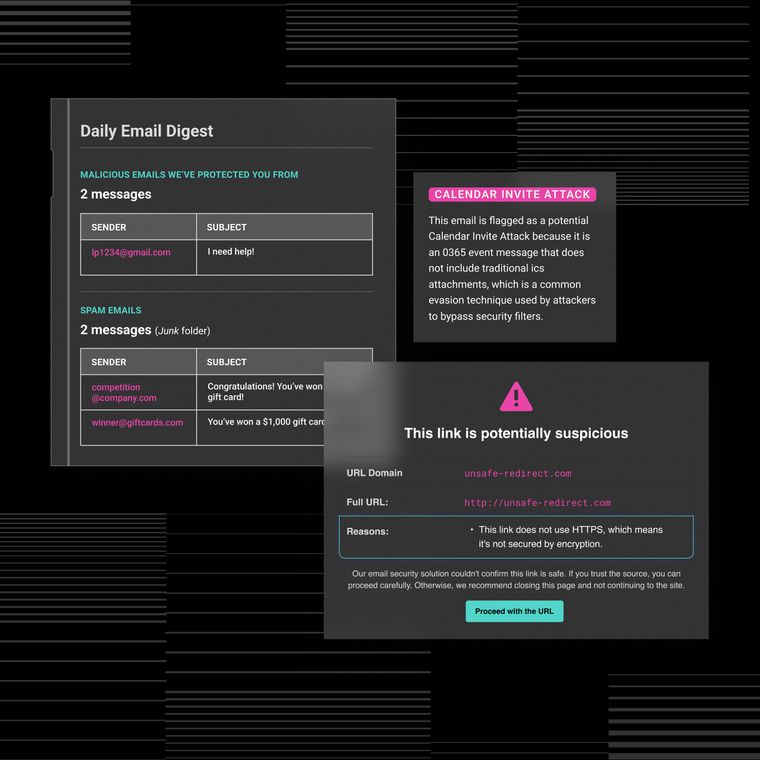Top Common Third Party Cyber Liability Risks - And How to Stay Ahead
See the most common third party cyber liability risks and how to lower your chances of being affected.
August 11, 2025
Attackers are increasingly exploiting trusted vendors, making third-party relationships one of the most significant cyber liabilities. The Verizon 2025 Data Breach Investigations Report shows 30% of breaches involved third parties, double last year’s rate, driven by vulnerability exploitation and business disruptions.
With rapid SaaS adoption, generative AI integration, and growing supplier networks, monitoring every partner is a mounting challenge. Also, weak vendor risk management can lead to regulatory penalties, reputational damage, and higher insurance costs. That’s why understanding the difference between first-party and third-party liability is the first step toward.
That said, read this article to understand the five most common vendor-driven threats and how to stay ahead by mitigating them.
What Are the Differences Between Third-Party and First-Party Cyber Liabilities
Cyber liability splits into two distinct categories that determine how you allocate budget, draft contracts, and structure insurance coverage.
First-Party Cyber Risks
These risks target your systems directly. Ransomware attacks that encrypt servers, breaches exposing employee data, and outages disrupting revenue all fall here. The financial impact includes forensics costs, system recovery, and lost productivity, which fall squarely on your organization. First-party cyber policies reimburse these direct operational costs.
Third-Party Cyber Risks
These emerge when security failures on your end harm external parties like customers, partners, or regulators. These incidents trigger lawsuits, contractual claims, and regulatory fines. Your liability persists even when the root cause originates with a vendor you selected, as detailed in analyses of third-party liability scenarios.
Cloud and SaaS agreements complicate this distinction by routinely shifting data protection responsibility back to the contracting organization. A breach in your provider's environment still activates your third-party obligations under existing service terms. This complexity makes understanding vendor-specific vulnerabilities critical to your risk management strategy.
That said, let’s take a closer look at third-party cyber liability risks:
1. Compromised Vendor Credentials
Vendor accounts pose a significant blind spot since you lack control over how partners manage passwords, keys, and tokens. Enforcing strong credential controls and maintaining continuous oversight transforms this risk into a managed asset and prevents attackers from using partner access to infiltrate your environment.
Recognize How Vendor Credentials Go Rogue
Vendors often hold elevated roles, from cloud service accounts to API keys, yet their security practices fall outside your governance. Weak controls, such as password reuse, no multifactor authentication, or inactive accounts left enabled, give attackers direct access. Stolen credentials are a common entry point, enabling activities like spinning up cloud resources for cryptomining and leaving customers with large bills before detection.
Reduce Exposure in Three Steps
To reduce the risk from compromised vendor accounts, start by requiring MFA for all vendor users and service accounts, and include contractual audit rights to verify compliance.
Next, monitor vendor activity in real time, flagging unusual login locations, resource spikes, or after-hours changes, and automatically revoke sessions when suspicious behavior is detected.
Finally, enforce immediate credential deactivation when contracts end or personnel change. These measures close a critical access gap and reduce both financial and legal risk, though evolving threats still require ongoing assessment.
2. Outdated or Incomplete Risk Assessments
Static vendor assessments create blind spots as threats evolve daily, with point-in-time reviews capturing past security posture and self-reported questionnaires often misrepresenting reality.
This outdated approach leaves organizations vulnerable to newly disclosed vulnerabilities, configuration drift, and untracked subcontractors long before the next annual audit. The risk increases when vendor inventories are incomplete because it becomes impossible to measure or mitigate exposure without knowing who has data access.
Continuous monitoring platforms address these gaps by tracking external signals, breach history, and configuration changes in real time. At the same time, effective strategies include reassessing critical vendors quarterly, automating alerts for posture changes, and linking contract renewals to measurable improvements.
This transforms vendor oversight from a compliance checkbox into active defense, although even advanced monitoring requires robust contractual controls to ensure security standards are met.
3. Weak Contractual Protections
Vendor agreements that gloss over cybersecurity can leave your organization absorbing breach costs when a supplier fails. Strong contracts close this gap by making responsibilities explicit, defining required controls, and granting enforceable oversight.
Here’s what you need to follow:
Each agreement should reference a recognized framework, such as NIST CSF or ISO 27001, as the security baseline, require multi-factor authentication, and mandate annual penetration tests with results shared.
Breach notification within 24 hours or less, along with joint forensics and coordinated customer outreach, is increasingly considered a best practice, even when not mandated by regulation.
Non-negotiable audit rights for both scheduled and ad hoc reviews must be included, with obligations flowing to all subcontractors.
To reduce financial exposure, contracts should require cyber liability coverage that matches potential impact and provide explicit indemnification for fines, litigation, and remediation costs.
Clear, specific language transforms vague promises into enforceable duties, shifting risk to the party that created it.
Well-crafted contracts turn cybersecurity expectations into binding obligations. This legal foundation ensures vendors remain accountable, protecting your organization from both operational and financial fallout.
4. Hidden Integrations and Shadow Access
Undocumented integrations and untracked access points expand your attack surface, creating liabilities your security team cannot defend if they remain unseen.
Expose and Control Rogue Connections
Unapproved APIs, unsanctioned SaaS plug-ins, and forgotten vendor accounts bypass routine audits, often lacking multifactor authentication, missing patches, and channeling data through unmonitored paths. Attackers exploit these hidden tools to pivot into core systems or extract regulated data, turning a single neglected endpoint into a multimillion-dollar incident. Reducing this risk begins with full discovery.
For this, you need to follow these steps:
Use continuous network monitoring to detect rogue traffic, map every API, and maintain a real-time asset inventory.
Centralize control through an API gateway, enforce least-privilege access, and off-board connections immediately when vendor relationships end.
Regularly review logs for unusual calls or data flows, as even a basic baseline can reveal anomalies that indicate compromise.
Treat visibility as a core security requirement, especially against advanced social engineering attacks that exploit trusted partner channels.
Remember, eliminating shadow access removes the hidden entry points attackers rely on. Full visibility ensures every integration is secured, monitored, and under your control.
5. Attacks That Start with a Trusted Partner
When attackers compromise a vendor’s mailbox, invoices, file links, and updates arrive from a trusted domain, evading filters and employee suspicion. Recent campaigns have used stolen supplier accounts and Microsoft branding to harvest credentials, then pivoted deeper into victim environments. Messages passed SPF and DKIM checks, blending into legitimate threads and bypassing traditional defenses.
Essential Safeguards
Because the attacks launched from trusted partners often bypass traditional defenses, reducing this risk starts with enforcing multi-factor authentication on all vendor accounts and implementing DMARC alongside SPF and DKIM for every domain in use. Establish communication baselines for each partner so that sudden language changes, unexpected payment details, or unusual login locations trigger immediate investigation.
Next, strengthen employee awareness with phishing simulations based on real partner scenarios, reinforcing the need to confirm requests out-of-band before acting. Complement these measures with behavioral analytics to uncover anomalies that both humans and static rules may miss.
Compromised partners can weaponize trust to bypass every perimeter. Verifying each message, no matter the sender, turns relationships into a security asset instead of a liability.
How Abnormal AI Gets You Ahead of Third-Party Risk
Abnormal’s behavioral AI detects vendor threats by learning partner communication patterns and flagging anomalies before they become breaches.
Behavioral AI Blocks Vendor Impersonation
Abnormal analyzes thousands of signals, such as IP addresses, writing style, login behavior, to spot sudden bank detail changes, unusual logins, or invoice spikes. This stops business email compromise and impersonation attacks missed by rules-based tools.
Security Posture Management Closes Access Gaps
Beyond email, Abnormal monitors OAuth tokens, excessive permissions, and cloud misconfigurations in Microsoft 365, prioritizing risks and guiding remediation to prevent vendor-related exploits.
Autonomous Agents Accelerate Threat Response
Autonomous AI agents triage alerts, deliver personalized phishing training based on actual attacker tactics, and reduce response times. This targeted approach equips employees to spot vendor-based social engineering attempts quickly, closing the human gap that attackers often exploit.
Rapid Deployment with Minimal Disruption
With native API integrations, Abnormal deploys across email and collaboration platforms in minutes with no policy tuning or user disruption required. This ensures you stay ahead of vendor-driven threats without slowing business operations.
Want to see how Abnormal can protect your organization from third-party risk? Book a personalized demo today.
Related Posts
Get the Latest Email Security Insights
Subscribe to our newsletter to receive updates on the latest attacks and new trends in the email threat landscape.


